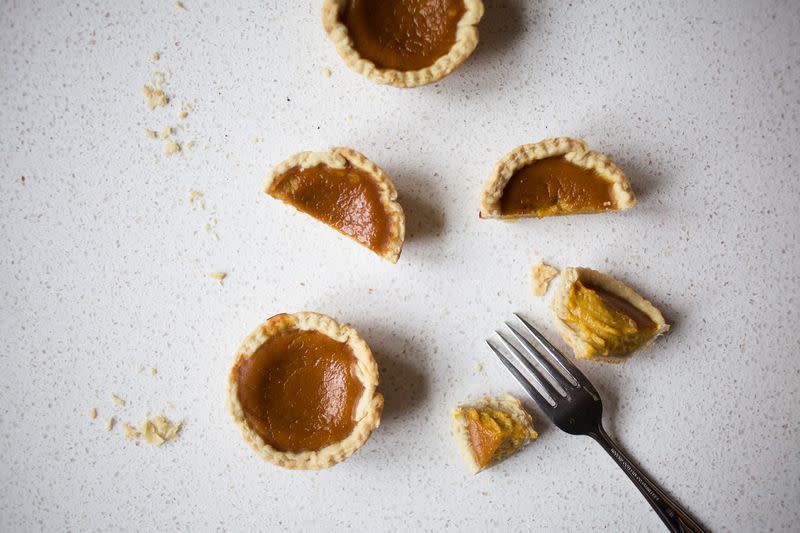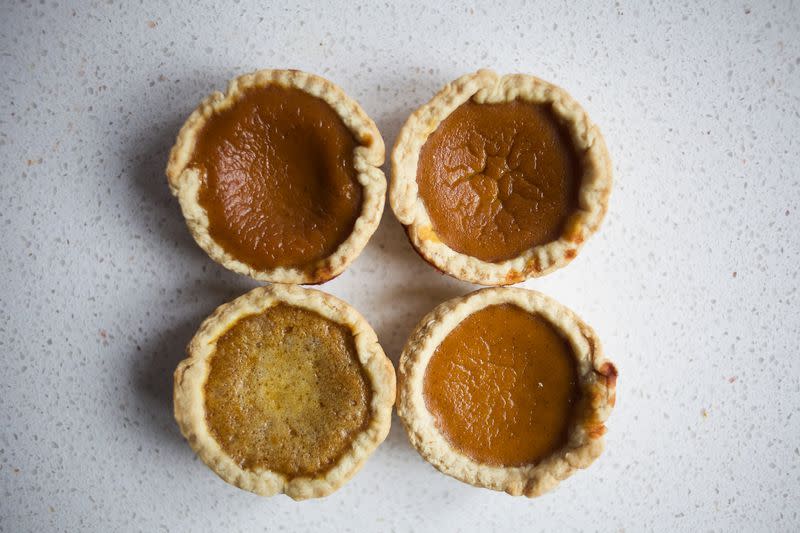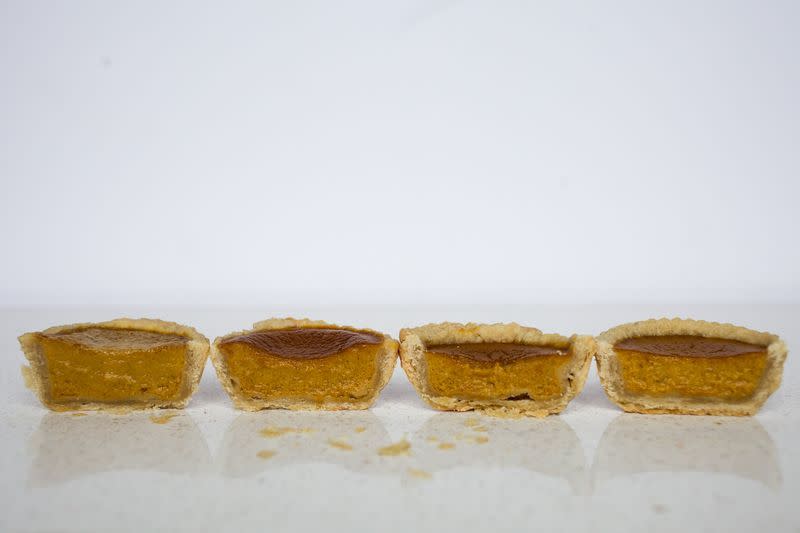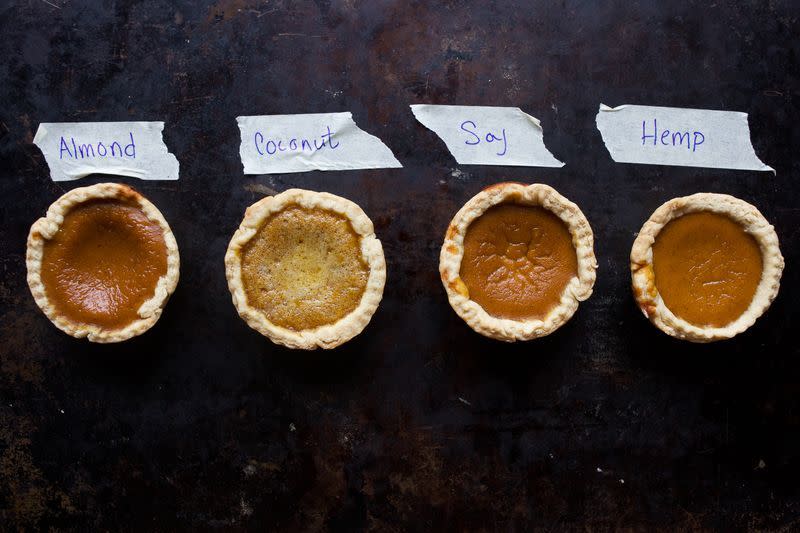These Are the Best Non-Dairy Milks to Use When Baking
We know how to sub vegan ingredients in for eggs when baking, but when it comes to using dairy-free milk—or mylk or the less-appealing “juice”—instead of regular milk, I wasn’t so sure what would happen.
Related: Non-Dairy Milks: Which to Make, Which to Buy

Which non-dairy milk bakes supreme(ly)? (Photo: Sophie of Wholehearted Eats/Food52)
To gear up for the holiday baking season, I did a test: How would almond, hemp, soy, and canned full-fat coconut milk fare in a pumpkin pie tart recipe? I swapped in the dairy-free milks in for regular milk a 1:1 ratio, and the results ranged from unacceptable to surprisingly good.
Related: How to Make Gluten- and Dairy-Free Pie Crust
Read on to find out which was the winner:

Clockwise from top right: almond, soy, hemp, and coconut milk. (Photo: Sophie of Wholehearted Eats/Food52)
Almond Milk: The almond milk pumpkin pie batter looked fairly normal. The color was nice and dark orange, and the consistency seemed average, if perhaps a little thin. Once baked, the tart top achieved a nice color, but the overall appearance wasn’t too pretty since the tart sunk, creating a large crater. The flavor was passable, but the filling separated a little, so the filling was watery. And that won’t do, will it?
Related: How to Make Dairy-Free, Vegan Coconut Ice Cream
Hemp Milk: Like the almond, the hemp batter looked good (albeit a little lighter in color). Again, it browned well and got that lovely pumpkin pie skin once cooked. The overall appearance looked the best out of the four, with no sinking or splitting. Yet, unlike the other milks, the taste of the hemp was overwhelming and made for a gritty filling.
Related: 15 Gluten-Free Baked Goods that Don’t Miss Gluten One Bit

From left to right: coconut, almond, soy, and hemp milk. (Photo: Sophie of Wholehearted Eats/Food52)
Soy Milk: Surprisingly enough, the soy mix seemed the thinnest of the four (I would have put my money on almond) and was definitely lighter in color than the hemp or almond mix. Again the finished product was nice—great color and browned top. There was a slight sinking in the middle along with small cracking. The consistency was creamy and smoother than the almond milk. Taste-wise, I couldn’t detect an “alternative” milk.
Related: A Gluten-Free Apple Crumble Pie to Keep All Your Guests Fed
Coconut Milk: First of all, the coconut milk had to be mixed really well to create a smooth consistency. Once added to the pumpkin, it made for the thickest mix. It baked well and like the hemp, didn’t sink. However, the fact that coconut milk fat is not homogenized meant that it separated during the baking, which led to an oily filling. While the filling had the right appearance and was the most light in color, it was also the lightest in consistency.
Related: The Challenges of Baking with Less Sugar (& How to Fix Them)

And the winner is…. (Photo: Sophie of Wholehearted Eats/Food52)
The Verdict
4th Place: Hemp. A little overpowering so would be better for a baked good with a lot of seeds or a nutty flavor.
3rd Place: Coconut Milk. I could see this working better in a quick bread, or muffin, but in something custard-based like this, it just won’t work.
2nd Place: Almond. This was overall not bad, but unfortunately it made for an ugly and watery pie. Past experience has proven that almond milk is great in pancakes, cookies, and cakes, but pumpkin pie is a solid “no.”
1st Place: Soy. I know. Such a typical verdict, but it made for the best pie for sure! It’s creamy like milk and bakes similarly, too. You won’t believe it’s not milk, I promise!
Overall, vegan milks can be subbed for conventional milks in a 1:1 ratio in almost all of your baking recipes. When it comes to things like cookies, cakes, biscuits, muffins, and pancakes, the type of milk used will not have a drastic effect on the end product. For richer desserts, such as a custard (like this pumpkin pie recipe), frosting, or a chocolate ganache, a creamy and more viscous milk (like soy) works best.
Dairy-Free Pumpkin Tarts
For the vegan pastry:
1 1/8 cups sifted or whole spelt flour
½ teaspoon salt
1 ½ tablespoons sugar
½ cup coconut oil or vegan shorting
½ cup Ice Water
1 tablespoon Apple Cider Vinegar
For the pumpkin filling:
1 can/398 milliliters pumpkin purée
6 tablespoons maple syrup
1 tablespoon molasses
1 teaspoon cinnamon
½ teaspoon sea salt
½ teaspoon ginger
¼ teaspoon nutmeg
2 eggs
1 cup milk of choosing (vegan or dairy)
In a food processor, pulse the flour, salt, and sugar to combine.
Add the cold coconut oil. Mix the vinegar with the water and slowly add a tablespoon at a time, just until the mixture holds together when lightly squeezed.
Flatten the dough into a disk (you may need to knead it a bit), and wrap in cling film, and chill for a couple of hours.
Once chilled, take out the dough and let soften up for a couple of minutes.
Preheat the oven to 350° F. I like to work in small batches, so I divided mine in half and rolled each half about an 1/8 inch (.30 centimeter) thick. I used a small bowl to cut out 5-inch (12-centimeter) circles, but anything around that size will do.
Press into a muffin pan, and using a fork, poke a few holes in the bottom of the tart. Chill until firm. Bake for 8 to 10 minutes.
For the pumpkin filling, mix all the ingredients together with a whisk until smooth.
Add pumpkin filling to the pre-baked shells, and bake for another 20 to 30 minutes, or until the filling is set but still jiggles.
By Sophie of Wholehearted Eats.

